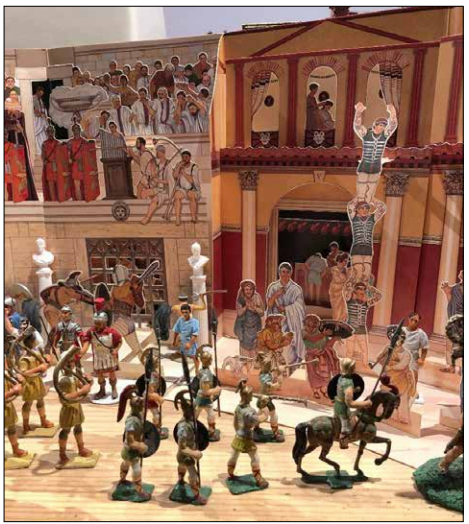Heyde figures originated in Dresden, Germany and are among the most prized in the world. The company produced figures mainly in the 48- and 60-mm scale. The company was bombed out during World War II, so its products became highly sought after post WW II.
A few good books have been produced on this company,1 but its history is not well known amongst
many English-speaking collectors. We do know that it was a thriving company producing such lines as
Egyptians, Trojans, Greeks including a temple, a Trojan horse, War elephants, Alexander the Great sets,
Romans, Chariots, Medieval Knights, Buffalo hunts, Cowboys and Indians and a Stagecoach (as illustrated in our Winter 2024 issue, (pp33-36)).

Much fun could be had playing or displaying their figures. Many sets were made for parades, but also
included trenches and figures in action representing the World War I period. Heyde specialized in figures of the various wars in Europe, including 19th century empires, FrancoPrussian War and World War I, and French Foreign Legion. The World War 1 sets included trench fighting, tanks, building and communications units, cannons. Civilian figures including children playing in a park in summer or winter, there were huntsmen chasing a fox and fairytale figures of Snow White and the seven dwarfs. Specialty sets could be produced – for example an airport, or arctic set including polar bears (and penguins!). Figures would sell originally for around a dollar a piece, and a full set in its original box was
$100 and up.
In my early years of my model soldier experience I was not aware of Heyde miniatures and its rich history. I started out knowing that most of my family had either served in the British or Canadian armed forces through many wars. A close family friend we called Uncle Frank was a staff sergeant in Scotland, then Canada. He initially bought me a set of Crescent highlanders for a birthday. That was 75 years ago and started me on a long love affair with model soldiers. We lived in Nova Scotia, and I would take my 25 cents allowance and head down to Woolworths and there I would buy 3 single Britains figures for seven cents apiece and have four cents left over! My first cannon was a Britains anti-aircraft
gun, costing seventy-five cents.
Many years later I was on vacation in Britain. My final stop was in Worthing on the south coast. I stayed for a few days with a family who were personal friends. While out browsing I found a pawnshop and I bought four 77 mm plastic German World War II figures. The day came when I had to take the train to London and fly home. The lady of the house handed me a small tin which I simply put in my carryon. During the train trip to London, I opened the tin and found seven small metal figures. It wasn’t until I returned home that I had a good look at them and discovered they were Heyde figures. The set comprised one calvary figure, two trumpeters and four Roman legionnaires. My heart skipped a beat as I realized what I now had to add to my collection. These figures are now proudly displayed on one of my Roman shelves leading a triumphal parade (see the accompanying images).

About the author:
Norman Cuthbert was originally from Toronto Canada and now lives in Charlotte, NC. He has served as choral leader and bandmaster and was a member of the Canadian Staff Band of The Salvation Army for
20 years. Norm is a member of the Ontario Model Soldier Society and the South Carolina Military Miniatures Society.
1 See for example Markus Grein who published the first book focusing just on Heyde figures: Mit Heyde-Figuren um die Welt / With Heyde-figures around the world Oct. 2003, Publisher: Krannich, Egon, Dr; ISBN-13 : 978-3933124166. More recently, T. Borges and F. Winckel wrote Heyde-Hunters, 2012. This well illustrated volume shows some of the best of the company’s sets.
